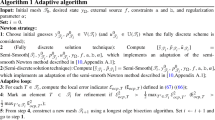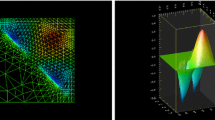Abstract
We present a technique for the rapid and reliable prediction of linear-functional outputs of elliptic coercive partial differential equations with (approximately) affine parameter dependence. The essential components are (i) (provably) rapidly convergent global reduced-basis approximations – Galerkin projection onto a space WN spanned by solutions of the governing partial differential equation at N selected points in parameter space; (ii) a posteriori error estimation – relaxations of the error-residual equation that provide inexpensive yet sharp bounds for the error in the outputs of interest; and (iii) off-line/on-line computational procedures – methods which decouple the generation and projection stages of the approximation process. The operation count for the on-line stage – in which, given a new parameter value, we calculate the output of interest and associated error bound – depends only on N, typically very small, and the (approximate) parametric complexity of the problem; the method is thus ideally suited for the repeated and rapid evaluations required in the context of parameter estimation, design, optimization, and real-time control.
In our earlier work, we develop a rigorous a posteriori error bound framework for the case in which the parametrization of the partial differential equation is exact; in this paper, we address the situation in which our mathematical model is not “complete.” In particular, we permit error in the data that define our partial differential operator: this error may be introduced, for example, by imperfect specification, measurement, calculation, or parametric expansion of a coefficient function. We develop both accurate predictions for the outputs of interest and associated rigorous a posteriori error bounds; and the latter incorporate both numerical discretization and “model truncation” effects. Numerical results are presented for a particular instantiation in which the model error originates in the (approximately) prescribed velocity field associated with a three-dimensional convection-diffusion problem.
Similar content being viewed by others
References
Akgun, M.A., Garcelon, J.H., Haftka, R.T.: Fast exact linear and non-linear structural reanalysis and the Sherman–Morrison–Woodbury formulas. International Journal for Numerical Methods in Engineering. 50(7), 1587–1606 (2001)
Allgower, E., Georg, K.: Simplicial and continuation methods for approximating fixed-points and solutions to systems of equations. SIAM Review. 22(1), 28–85 (1980)
Almroth, B.O., Stern, P., Brogan, F.A.: Automatic choice of global shape functions in structural analysis. AIAA Journal. 16, 525–528 (1978)
Balmes, E.: Parametric families of reduced finite element models: Theory and applications. Mechanical Systems and Signal Processing. 10(4), 381–394 (1996)
Barrett, A., Reddien, G.: On the reduced basis method. Z. Angew. Math. Mech. 75(7), 543–549 (1995)
Chan, T.F., Wan, W.L.: Analysis of projection methods for solving linear systems with multiple right-hand sides. SIAM Journal on Scientific Computing. 18(6), 1698,1721 (1997)
Farhat, C., Crivelli, L., Roux, F.X.: Extending substructure based iterative solvers to multiple load and repeated analyses. Computer Methods in Applied Mechanics and Engineering. 117(1–2), 195–209 (1994)
Fink, J.P., Rheinboldt, W.C.: On the error behavior of the reduced basis technique for nonlinear finite element approximations. Z. Angew. Math. Mech. 63, 21–28 (1983)
Machiels, L., Maday, Y., Oliveira, I.B., Patera, A.T., Rovas, D.V.: Output bounds for reduced-basis approximations of symmetric positive definite eigenvalue problems. C. R. Acad. Sci. Paris, Série I. 331(2), 153–158 (2000)
Maday, Y.: Private communication
Maday, Y., Patera, A.T., Rovas, D.V.: A blackbox reduced-basis output bound method for noncoercive linear problems. In D.Cioranescu and J.-L. Lions (eds.), Nonlinear Partial Differential Equations and Their Applications, Collége de France Seminar Volume XIV. Elsevier Science B.V. 2002, pp. 533–569, Amsterdam: North Holland
Maday, Y., Patera, A.T., Turinici, G.: Global a priori convergence theory for reduced-basis approximation of single-parameter symmetric coercive elliptic partial differential equations. C. R. Acad. Sci. Paris, Série I. 335, 1–6 (2002)
Noor, A.K., Peters, J.M.: Reduced basis technique for nonlinear analysis of structures. AIAA Journal. 18(4), 455–462 (1980)
Peterson, J.S.: The reduced basis method for incompressible viscous flow calculations. SIAM J. Sci. Stat. Comput. 10(4), 777–786 (1989)
Porsching, T.A.: Estimation of the error in the reduced basis method solution of nonlinear equations. Mathematics of Computation. 45(172), 487–496 (1985)
Prud’homme, C., Rovas, D., Veroy, K., Maday, Y., Patera, A.T., Turinici, G.: Reliable real-time solution of parametrized partial differential equations: Reduced-basis output bound methods. Journal of Fluids Engineering. 124(1), 70–80 (2002)
Quarteroni, A.,Valli, A.: Numerical Approximation of Partial Differential Equations. 2nd edn. New York: Springer-Verlag 1997
Rheinboldt, W.C.: Numerical analysis of continuation methods for nonlinear structural problems. Computers and Structures. 13(1–3), 103–113 (1981)
Rheinboldt, W.C.: On the theory and error estimation of the reduced basis method for multi-parameter problems. Nonlinear Analysis, Theory, Methods and Applications. 21(11), 849–858 (1993)
Solodukhov, Y.: Reduced-Basis Methods Applied to Locally Non-Affine Problems. PhD thesis, Massachusetts Institute of Technology, 2004, In progress
Strang, G., Fix, G.J.: An Analysis of the Finite Element Method. Englewood Cliffs, NJ: Prentice-Hall 1973
Veroy, K.: Reduced-Basis Methods Applied to Problems in Elasticity: Analysis and Applications. PhD thesis, Massachusetts Institute of Technology, April 2003
Veroy, K., Rovas, D., Patera, A.T.: A posteriori error estimation for reduced-basis approximation of parametrized elliptic coercive partial differential equations: “convex inverse” bound conditioners. Control, Optimisation and Calculus of Variations. Special Volume: A tribute to J.-L.Lions. 8, 1007–1028 (2002)
Wendland, W.L.: Elliptic Systems in the Plane. London, San Francisco: Pitman 1979
Yip, E.L.: A note on the stability of solving a rank-p modification of a linear system by the Sherman–Morrison–Woodbury formula. SIAM Journal on Scientific and Statistical Computating. 7(2), 507–513 (1986)
Author information
Authors and Affiliations
Corresponding author
Additional information
Communicated by
M.S. Espedal, A. Quarteroni, A. Sequeira
Rights and permissions
About this article
Cite this article
Prud’homme, C., Patera , A. Reduced-basis output bounds for approximately parametrized elliptic coercive partial differential equations. Comput Visual Sci 6, 147–162 (2004). https://doi.org/10.1007/s00791-003-0119-7
Received:
Accepted:
Published:
Issue Date:
DOI: https://doi.org/10.1007/s00791-003-0119-7




